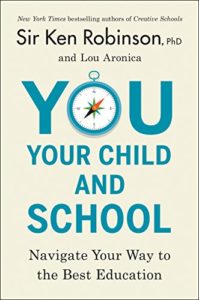 Sir Ken Robinson and Lou Aronica previously argued in their 2015 book Creative Schools (reviewed here) that we should pursue individualized and holistic learning. The duo have now written a sequel of sorts, for parents of school age children. In You, Your Child, and School: Navigating Your Way to the Best Education Robinson and Aronica: 1) review the ways society is changing and the implications for education; 2) note several challenges related to ensuring students receive a quality education; and 3) help parents analyze how to overcome these challenges so that their children get the education they need to live fulfilled lives.
Sir Ken Robinson and Lou Aronica previously argued in their 2015 book Creative Schools (reviewed here) that we should pursue individualized and holistic learning. The duo have now written a sequel of sorts, for parents of school age children. In You, Your Child, and School: Navigating Your Way to the Best Education Robinson and Aronica: 1) review the ways society is changing and the implications for education; 2) note several challenges related to ensuring students receive a quality education; and 3) help parents analyze how to overcome these challenges so that their children get the education they need to live fulfilled lives.
Great parents create the conditions that support their children’s growth. They work to ensure that the needs in Maslow’s famous hierarchy of needs– physiological, safety, love/belonging, esteem, self-actualization—are fulfilled for their children. They recognize that there are, as Howard Gardner has argued, multiple types of intelligence, and they help their children identify their talents. Great parents recognize that different aspects of development (e.g., cognitive, emotional, physical) co-occur and impact one another. They encourage a lot of play, especially outside. Finally, great parents encourage healthy sleep and exercise habits to help mitigate the substantial stress that students experience. Great teachers help students stay excited about learning, build students’ confidence, demonstrate passion, focus on relationships, and are experts in knowing how people learn.
Quality education supports students in becoming fulfilled and engaged adults by supporting the development of the eight competencies Robinson and Aronica detailed in Creative Schools: curiosity, creativity, criticism, communication, collaboration, compassion, composure, and citizenship. These competencies help students develop socially, emotionally, and culturally. Quality education is practical, showing connections between theory and practice to help engage students.
Quality education also prepares students for the future. Today’s typical education may not be the best way to prepare kids for the future because it is difficult to know what jobs today’s students will hold. Robinson and Aronica argue that a college degree, which has become increasingly expensive, is no longer a guarantee of a good job. The emphasis on science, technology, engineering, and math fields not only leads to some students being less engaged in school, but it may also be ignoring ways in which the arts and humanities help students develop important workforce skills. They argue that we are doing a disservice both to students and to society by not offering more vocational education courses in high school and not endowing vocational tracks with more respect. One out of every three jobs requires non-college professional training, and yet only 12% of people have that training. These jobs can be fulfilling and even pay commensurate with jobs that require a college degree. Parents, children, and schools should work together to find the best educational and career path for each child.
Robinson and Aronica suggest several factors for parents to consider when determining whether a school will fit their child’s needs. They suggest parents look for schools with a broad, balanced, and dynamic curriculum that teaches not only the academic disciplines but also physical education, arts, and social and life skills. Parents should consider whether teachers flexibly modify their practice to students’ needs. Parents should seek schools that use assessments that are open, informative, and ongoing. School schedules ideally are flexible and varied. The environment should be safe and stimulating. Schools should capitalize on and contribute to the wider community.
When the local public school does not have these elements, Robinson and Aronica argue that parents can change the schools from within them or from outside of them. They can also take their children out of the school system. They draw on the work of Jerry Mintz to list indicators for homeschooling or “unschooling” a child. They suggest that parents can try to connect more with their child’s teachers, get involved with the school (e.g., volunteering in the library), participate in school governance (e.g., parent teacher associations), or advocate for changes to education policy. They offer advice about how parents should behave when raising a complaint and what parents should expect from their child’s school in addressing their concern. Robinson and Aronica offer advice also about common problems that kids face in school, e.g., homework, stress, bullying, and attentional issues.
Consistent with a message these authors have shared previously, the main theme in You, Your Child, and School,is one that is not new to parents and yet is reassuring to have affirmed: every child is unique, one type of education is not appropriate for all students, and life is not linear. Parents and educators alike can better serve children when bearing this in mind.
Robinson, K., & Aronica, L. (2018). You, Your Child, and School: Navigating Your Way to the Best Education. New York, NY: Viking Penguin.



